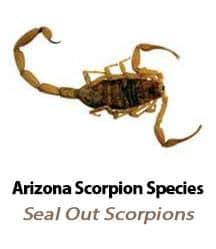Arizona Scorpion Species
The Arizona Bark Scorpion Profile
- Highly Venomous Scorpion Species
- Arboreal (an Avid Climber)
- Attracted to our Residential Lots and Homes
- Has Behaviors that Help Protect It from Insecticides.
Arizona Bark Scorpion Centruroides sculpturatus
 The Arizona Bark Scorpion is most commonly encountered in urban areas and home structures and is also the most venomous scorpion in the United States.
The Arizona Bark Scorpion is most commonly encountered in urban areas and home structures and is also the most venomous scorpion in the United States.
These scorpions are light tan to yellow-brown and are 1-3 inches long including tail. This scorpion species can be found in Southeast California, southwest New Mexico, Mexico, and throughout Arizona; They are the only scorpion in Arizona with the strong ability and strong tendency to climb. They can be found on walls or upside down on ceilings and can climb on almost all surfaces.
Arizona Bark scorpions are also the only social scorpions likely found in urban areas. They may group in large numbers, especially in and around cinder-block walls, yet they do not burrow, nest or colonize. In general, insecticides alone are often very ineffective in helping control neighborhood and property scorpion populations.
Arizona Bark scorpions seek out dark places they can squeeze into. This includes a variety of natural and man-made places: tree bark, rocks, vegetation litter, potted plants, patio furniture, door mats, narrow cracks in wood, cement and openings throughout the inside and outside of homes.
Less Common Arizona Scorpion Species That Enter Homes
- Striped-tail Scorpion – Vaejovis
- Striped-tail scorpions look very similar to bark scorpions but have thicker pincers and tails. They have thin, dark stripes along the underside of the tail, and are burrowing scorpions. Striped-tail scorpions are not as common to find inside the home and their venom is mild and not typically a health concern unless an allergic reaction occurs.
- Giant Desert Hairy Scorpion – Hondrurus Arizonesis
- This is the largest scorpion species in North America with individuals capable of growing up to 6 inches. They are rarely found in structures, but occasionally can be found around doors or garages after heavy rains or flooding. They are typically found in or near washes where they burrow deeply. Their venom is mild and their sting is comparable to that of a bee.
Scorpion-like Species Pseudoscorpionida, Solifuugae, Uropygi
Psuedoscorpions, Solpugids and Whip-scorpions at first glance can be mistaken for a scorpion. While they occasionally enter homes and are scary, they are not a threat to humans.
Written By:
Georgia Clubb – Seal Out Scorpions
gclubb@sealoutscorpions.com
www.sealoutscorpions.com
Questions
Other Than Quotes












